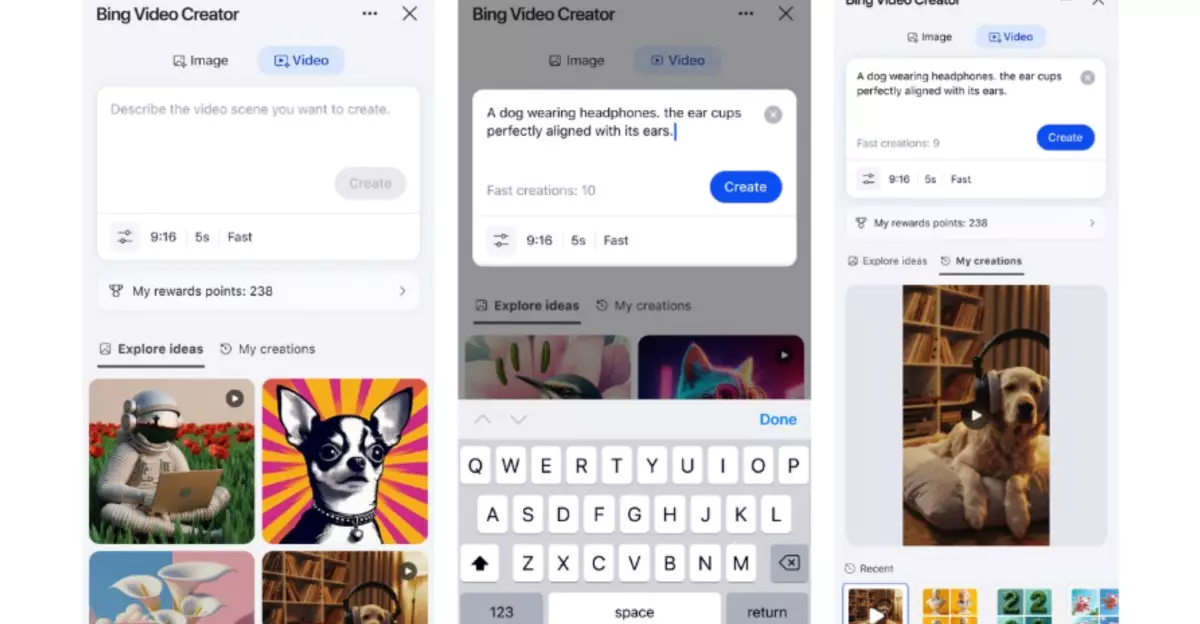In an unprecedented move that aims to democratize creativity, Microsoft has taken a bold step in the realm of artificial intelligence with the launch of its AI-powered video generator in the Bing mobile app. This innovative tool, built upon OpenAI’s Sora text-to-video technology, allows users to create short videos without the usual paywalls associated with such high-caliber technology. By providing this service at no cost, Microsoft is challenging the existing paradigms of video content creation, making it accessible to a broader audience than ever before.
The underlying philosophy driving this initiative speaks volumes about Microsoft’s vision of creativity. As they articulated in their announcement, “creativity should be effortless and accessible.” This standpoint resonates with creative individuals who often find themselves constrained by resources or technical know-how that prevent them from producing high-quality visual content. With the Bing Video Creator, users can potentially unleash their innovative ideas without financial burdens.
A Seamless User Experience
The accessibility offered by the Bing Video Creator cannot be overstated. Rolling out globally to Android and iOS platforms, this feature invites users to integrate video creation into their routine search experience. Simply by tapping into the app’s options or entering desired descriptions into the search bar, users can effortlessly queue multiple video requests. This intuitive functionality is designed to cater to the needs of both seasoned creators and novices.
Additionally, users can choose between varied generation speeds. The “Standard” speed allows for a steady pace, while the “Fast” option claims to deliver instant results. This structuring accommodates diverse user preferences, ensuring everyone has a chance to experiment with video creation, whether they need a quick turn-around for social media or more deliberative polished content.
Parameters and Limitations
However, not all that glitters is gold. While the capacity to produce five-second videos in a 9:16 vertical format presents an exciting opportunity, it is crucial to consider the limitations that come with it. The short duration may restrict the substance of the content, leaving creators feeling pressured to condense their messages into a mere flicker. Furthermore, once users exhaust their ten Fast generative attempts for free, they face either a slowdown to Standard speeds or the need to redeem Microsoft Rewards points. While this may not be seen as egregiously restrictive, it could deter spontaneous creation, something that is often paramount in the fast-moving digital landscape.
The addition of storage for 90 days further amplifies the potential for users to curate their content. However, 90 days might feel fleeting for those who want to nurture their creations over time, especially as longer-term projects develop.
Visual Quality: The Elephant in the Room
A critical aspect that looms large over this launch is the quality of the videos produced. Early demonstrations, including whimsical clips featuring an otter chef and a hamster, prompt a polarized response. Comparisons with other AI models, particularly Google’s Veo 3, reveal noticeable discrepancies in visual stitching and motion fluidity. Users have reported that the movements often appear unnatural, bringing into question how effectively the AI can replicate human creativity.
Despite these critiques, Microsoft has emphasized that their showcased examples were a fair representation of what the technology can offer. While they may not reach the polish exhibited in OpenAI’s curated clips, these demos do provide an authentic glimpse into the capabilities and limitations of AI-generated content. As a nascent technology, improvements can be anticipated with subsequent updates, potentially positioning Microsoft as a formidable contender in the AI video landscape.
Future Implications for Content Creation
The introduction of the Bing Video Creator signifies more than just the addition of a tool—it reflects a cultural shift toward greater accessibility in creative expression. By removing barriers tied to cost and expertise, Microsoft is paving the way for a new generation of content creators. As users become increasingly empowered to transform their words into engaging visuals, we might witness a surge in creativity that transcends traditional media boundaries.
This initiative also holds the potential to reshape industries reliant on visual storytelling. From influencers to marketers, professionals in various fields will have the opportunity to leverage this technology for enhanced engagement. As the boundaries of AI creativity continue to stretch, we might see a profound impact on how content is created, distributed, and perceived in an ever-evolving digital landscape.


Leave a Reply